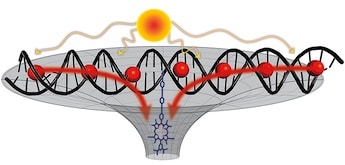
The modular molecular composite nanosystems (MMCNs) approach to developing atomically precise manufacturing, described in the 2007 Technology Roadmap for Productive Nanosystems, proposes using DNA scaffolds to organize smaller functional components to execute complex tasks. In another demonstration of the functional utility of DNA scaffolds, scientists in Sweden have used DNA scaffolds to position dye molecules to increases the efficiency of artificial photosynthesis. A hat tip to ScienceDaily for reprinting this news release from Chalmers University of Technology “DNA constructs antenna for solar energy“:
A research team at Chalmers University of Technology has made a nanotechnological breakthrough in the first step required for artificial photosynthesis. The team has demonstrated that it is possible to use self-assembling DNA molecules as scaffolding to create artificial systems that collect light. The results were recently published in the esteemed scientific Journal of the American Chemical Society [abstract].
Scaffolding in plants and algae consists of a large number of proteins that organise chlorophyll molecules to ensure effective light collection. The system is complicated and would basically be impossible to construct artificially.
“It’s all over if a bond breaks,” says Jonas Hannestad, PhD of physical chemistry. “If DNA is used instead to organise the light-collecting molecules, the same precision is not achieved but a dynamic self-constructing system arises.”
With a system that builds itself, the researchers have begun to approach nature’s method. If any of the light-collecting molecules break, it will be replaced with another one a second later. In this sense, it is a self-repairing system as opposed to if molecules had been put there by researchers with synthetic organic chemistry.
The sun’s light is moved to a reaction centre in plants and algae so they can synthesise sugars and other energy-rich molecules.
“We can move energy to a reaction centre, but we have not resolved how the reactions themselves are to take place there,” says Bo Albinsson, professor of physical chemistry and head of the research team. “This is actually the most difficult part of artificial photosynthesis. We have demonstrated that an antenna can easily be built. We have recreated that part of the miracle.”
The Chalmers researchers are combining artificial photosynthesis with DNA nanotechnology. When constructing nano-objects that are billionths of a metre, DNA molecules have proven to function very well as building material. This is because DNA strands have the ability to attach to each other in a predictable manner. As long as the correct assembly instructions are given from the start, DNA strands in a test tube can bend around each other and basically form any structure.
“It’s like a puzzle where the pieces only fit together in one specific way,” says Bo Albinsson. “That is why it is possible to draw a fairly complex structure on paper and then know basically what it will look like. We subsequently use those traits to control how light collection will take place.
This appears from the abstract to be a quite simple scaffold consisting of a 39-base pair linear configuration, although the authors mention further improvements through the use of a more complex hexagonal configuration. Perhaps this work will lead to larger, more complex scaffolds in which greater numbers of functional components are precisely arranged.
—James Lewis, PhD